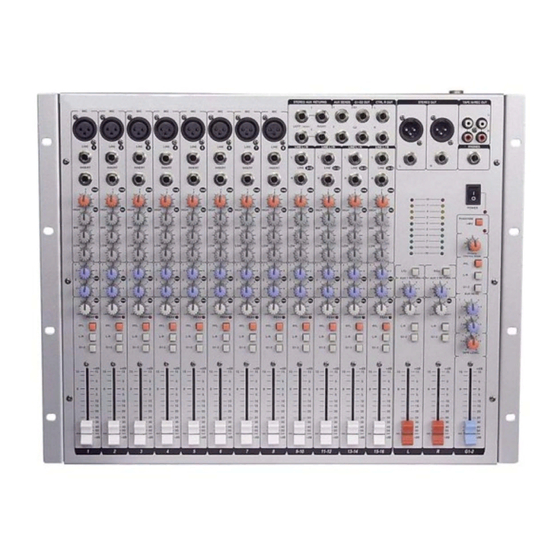DAPAudio LIVE 16 사용자 설명서 - 페이지 8
{카테고리_이름} DAPAudio LIVE 16에 대한 사용자 설명서을 온라인으로 검색하거나 PDF를 다운로드하세요. DAPAudio LIVE 16 19 페이지.

Input-Channel-Section
1) MIC
Electronically balanced XLR-connector input socket. For connecting low signal
sources such as microphones or other low impedance devices. +48V Phantom Power
on each input MIC socket.
2) LINE
Balanced or unbalanced 1/4 (Ø 6.35mm) Stereo jack input socket. For connection
with high level sound sources, such as keyboards, electric guitars, electronic musical
instruments or audio playback units. Mono-connectors can also be used for automatic
signal unbalancing. When connecting a turntable, only use an external R.I.A.A. Pre-
amplifier.
3) INSERT
Stereo-Jack-connector (Ø 6,3 mm). For connecting the input and output of a remote
device such as a noise gate, compressor or equalizer in series with the channel. The
command is only available in mono channels. TIP = Signal input, Ring = MIC Signal
output
4) TRIM)
With this function you can adjust the input sensitivity (-∞ to +20 dB) of each channel in
order to get a constant level signal.
5) HIGH:
Controls the high range of signals (+15 dB). When the knob is centrally positioned
(zero point), sound tone remains unchanged. Turn the knob anti-clockwise to
gradually reduce high frequencies (vocals with less hiss, reduction of background
noise, cymbals less cutting, etc.). Turn the knob clockwise to boost high frequencies
(sound are highlighted, vocals are more intelligible, signal harmonics are
emphasized).
6) MID:
Controls the mid range of signals (+15 dB). When the knob is centrally positioned
(zero point), sound tone remains unchanged. Turn the knob anti-clockwise to
gradually reduce mid frequencies (reduction of mid part of sound, tones at extremes
of high and low ranges are emphasized, typical of dance music tones). Turn the knob
clockwise to boost mid frequencies (sound body is highlighted, greater overall sound
power and more nasal tone).
7) LOW:
Controls the low range of signals (+15 dB). When the knob is centrally positioned
(zero point), sound tone remains unchanged. Turn the knob anti-clockwise to
gradually reduce low frequencies (boom is neutralized, excessively low sounds are
removed). Turn the knob clockwise to boost low frequencies (more full-bodied sound,
highlighting of main signal frequencies, percussive sound more pronounced).
6
